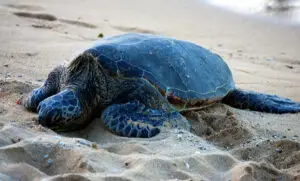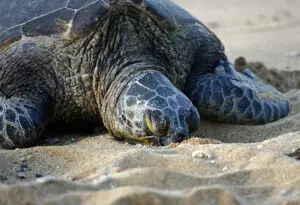Ever found yourself wondering about the mysterious and fascinating world of sea turtles? Well, here’s a question that might pique your curiosity: How do sea turtles sleep? These incredible creatures, gracefully gliding through the ocean depths, have some unique sleeping habits that might just leave you in awe.
Sea turtles have developed a remarkable adaptation known as “unihemispheric slow-wave sleep” or USWS. This means that only one hemisphere of their brain sleeps at a time, allowing them to maintain essential functions such as swimming, surfacing for air, and staying alert to potential threats.
This unique sleep pattern is crucial for their survival in the open ocean, where predators and obstacles abound. also, during this sleep mode, one half of the turtle’s brain remains active and vigilant, while the other half experiences slow-wave sleep.
This adaptation enables sea turtles to rest and conserve energy while still being aware of their surroundings and potential dangers.
Importance of understanding sea turtle sleep patterns

Understanding sea turtle sleep patterns is crucial for several reasons, as it contributes to the overall conservation and management of these endangered species. Here are some key points highlighting the importance of studying sea turtle sleep patterns:
- Conservation Efforts:
- Knowledge of sea turtle sleep patterns helps in designing effective conservation strategies. By understanding when and where sea turtles sleep, conservationists can implement measures to protect them during vulnerable periods.
- Nesting Behavior:
- Female sea turtles come ashore to nest, and understanding their sleep patterns is essential for protecting nesting sites. Disturbances during their sleep can lead to stress and affect their reproductive success.
- Hatchling Survival:
- Hatchlings are vulnerable to predation and environmental challenges during their journey from the nest to the sea. Knowing when sea turtles are more active or inactive helps in identifying critical periods for hatchling survival and implementing protective measures.
- Migration and Navigation:
- Sea turtles undertake long-distance migrations, and understanding their sleep patterns can provide insights into their navigation and orientation mechanisms. This knowledge is crucial for creating marine protected areas and ensuring their safe passage during migration.
- Impact of Human Activities:
- Coastal development, light pollution, and recreational activities can disrupt sea turtle sleep patterns. Studying their behavior helps identify potential threats and allows for the development of guidelines to mitigate human impacts.
- Health and Physiology:
- Sleep is essential for the overall health and well-being of animals. Studying sea turtle sleep patterns provides insights into their physiological processes, stress levels, and overall health, which is vital for their long-term survival.
- Climate Change Impacts:
- Climate change affects sea turtle habitats, including temperature variations and changes in food availability. Understanding how sleep patterns may be influenced by these environmental changes helps scientists anticipate and mitigate potential impacts on sea turtle populations.
- Legal Protection and Policy Development:
- The data on sea turtle sleep patterns can be used to inform and develop protective legislation and policies. Governments and conservation organizations can use this information to establish regulations that safeguard sea turtles and their habitats.
- Educational Outreach:
- Understanding sea turtle sleep patterns provides opportunities for educational outreach. It allows scientists, educators, and conservationists to raise awareness about the importance of protecting these species and their habitats.
The Need for Sleep in Sea Turtles
The need for sleep in sea turtles, as in other animals, is associated with various physiological and behavioral functions:
- Restoration of Energy: Sleep is crucial for the restoration of energy levels. During sleep, the body can conserve energy and allocate resources for essential physiological processes, helping sea turtles maintain their overall health.
- Memory Consolidation: Sleep is thought to play a role in memory consolidation, allowing animals to process and store information acquired during their waking hours. This is important for sea turtles in tasks such as navigation and finding suitable nesting sites.
- Temperature Regulation: Sea turtles are ectothermic, meaning their body temperature is influenced by the external environment. Resting and sleeping in certain areas, such as basking in the sun or finding warmer waters, may help sea turtles regulate their body temperature.
- Predator Avoidance: While sea turtles are adapted to spend a significant amount of time in the water, they still come ashore to nest. During these times, they may be more vulnerable to predators. Sleeping in safe areas and adopting specific sleeping behaviors could contribute to predator avoidance.
- Maintenance of Biological Rhythms: Sleep is often tied to the circadian rhythms of an animal. Maintaining these biological rhythms is important for various physiological functions, including hormone regulation, immune system function, and overall well-being.
How do sea turtles sleep?

Sea turtles sleep in a way that’s different from humans. They don’t close their eyes and doze off like we do. Instead, they have a unique way of resting.
Here’s a simple explanation:
- Underwater Naps: Sea turtles spend a lot of time in the water, and they can actually take naps underwater. They have the ability to hold their breath for a long time, so they might find a safe spot to rest on the ocean floor. Some sea turtles can even sleep while floating in the water.
- Special Brain Activity: When sea turtles are resting or napping, their brain shows a pattern of slow-wave sleep. It’s like a low-energy mode for their brains, helping them conserve energy.
- No True REM Sleep: Unlike humans, sea turtles don’t experience rapid eye movement (REM) sleep, which is associated with dreaming in people. Instead, their sleep is more straightforward, with periods of lower brain activity.
- Temperature Regulation: Sea turtles, being cold-blooded animals, might also use sleep as a way to regulate their body temperature. For instance, they might bask in the sun during the day to warm up and then find cooler waters to rest at night.
So, sea turtles have this interesting way of taking underwater naps, adjusting their sleep to their ocean environment, and using it to help with things like conserving energy and staying safe from predators. It’s a unique adaptation that suits their life in the sea.
Understanding Sea Turtle Sleep Patterns


